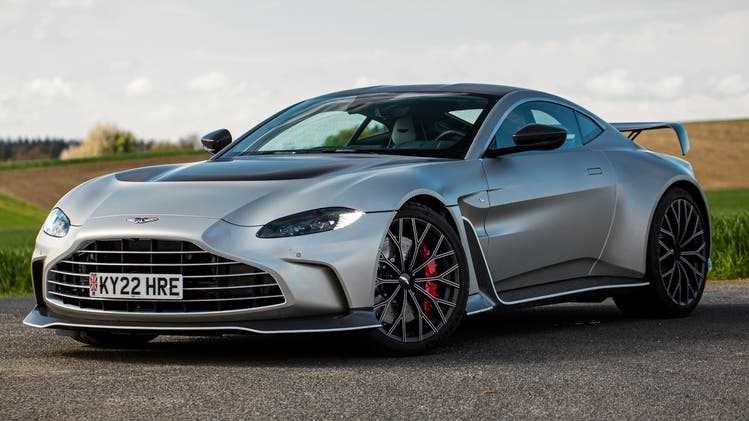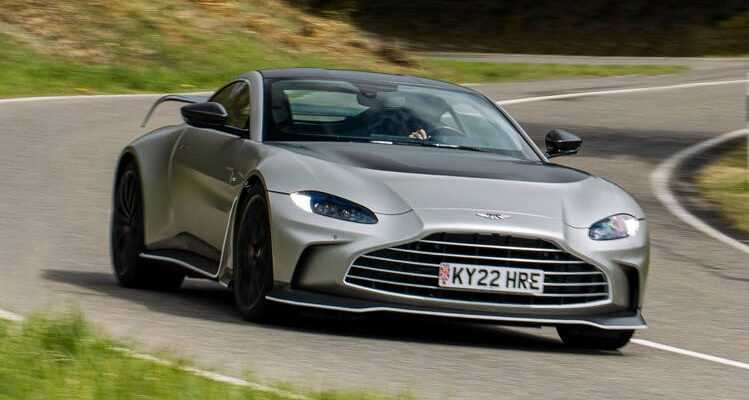With a special series, the big V12 says goodbye to the smallest model, the Vantage. We drove the already visually impressive 700 hp two-seater in the Eifel.
Larger front grille, additional openings and powerful rear wing: the Aston Martin V12 Vantage should attract attention.
The fact that Aston Martin does not come to rest can be judged one way or the other. With the ex-Ferrari boss Amedeo Felisa, who has now replaced the ex-AMG boss Tobias Moers after just two years at the helm of the British sports car manufacturer, the British are already the third CEO within three years to clean up. On the other hand, the luxury car manufacturer is constantly launching new, extremely dynamic models on the market that not only move connoisseurs physically but also emotionally.
This undoubtedly includes the new V12 Vantage Coupé, which will be built in a limited edition of 333 units. The smallest Aston Martin with the thickest engine says goodbye to the group of combustion super sports cars forever. Reason enough for a farewell tour through the Eifel with a prototype including a 700 hp biturbo V12.
But before that, it’s worth pointing out one of the few constants at Aston Martin: the design – no wonder, since Marek Reichman has been responsible for that since 2005, who sees himself less as a car stylist and more as a design engineer. With the new V12 Vantage, he has once again managed to design the necessary ventilation and aeration as well as the many aerodynamic helpers in an elegant way.
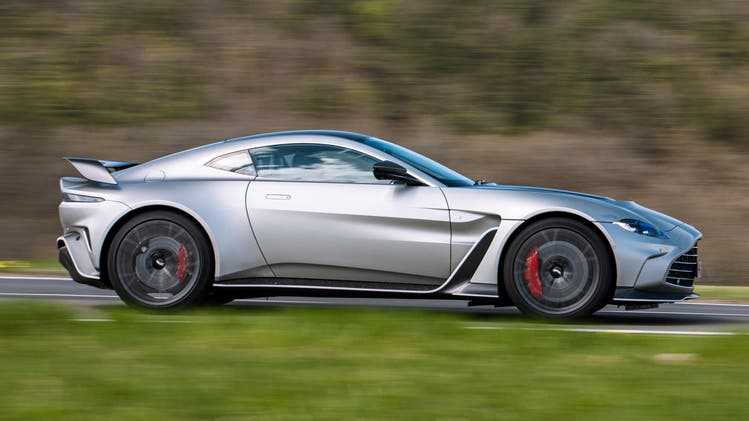
Successful farewell performance: The V12 Vantage offers everything that is available in the Vantage technology kit.
In order to perfect the engine and power visually, he widened the Vantage body by 40 millimeters and gave the widebody design a wonderful carbon aerodynamics package. The front splitter provides additional downforce across the entire width. To increase airflow through the engine radiators, the front grille has grown by 25 percent. Reichman has cleverly integrated the necessary additional engine ventilation into the hood in a horseshoe design.
The sills are reshaped, and at the rear, a bumper with an integrated diffuser maintains front-to-rear aerodynamic balance. Reichman placed the twin tailpipe exhaust system in the middle, surmounted by a rear wing that is as conspicuous as it is removable and contributes to a maximum downforce of 204 kilos at a top speed of 322 km/h.
Not much has happened inside. Standard are “Sports Plus” seats with full semi-aniline leather, optionally there is a new carbon fiber performance seat with visible carbon shell and manual six-way adjustment as in our roadworthy prototype. A small loop on the upper edge of the seat between the legs is interesting: if you pull it, the seat can be pushed back and forth.
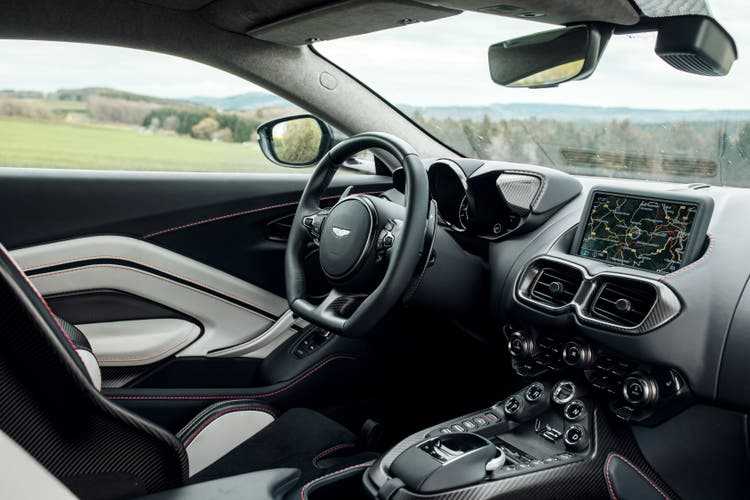
The interior has not changed in layout. There’s also a non-touch screen and one-touch gear selection.
The center console is dominated by large and small buttons, with a small rotary wheel you can regulate the volume of the infotainment system. A small (non-touch) screen sits firmly atop the dashboard, and the only assistant is the one that helps with parking. Which is useful, however, because you can’t see much to the rear – also because the rear wing divides the view horizontally to the rear. The driver receives all necessary information such as engine speeds, the selected gear and the speed from a central digital round instrument, which changes its color to red and even redder depending on the selected driving mode (there is only GT, Sport, Sport+). Otherwise you indulge in leather, the slightly hexagonal steering wheel convinces with a mix of leather and carbon.
Unfortunately, you don’t see much of the powerful 5.2-liter V12 biturbo under the hood. It seems to at least fill the available space fully (the engineers stuffed a V12 into the smallest Aston for the first time in 2009, at that time with 517 hp, followed in 2013 by the 5.9-liter twelve in the V12 Vantage S with 573 hp) and cannot be a lightweight : Overall, the V12 Vantage weighs almost 1.8 tons, despite many composite parts (front hood and fenders, side skirts, rear bumper, trunk lid). But 700 hp and 753 Nm maximum torque laugh about it. On paper, the mighty athlete sprints from 0 to 100 km/h in 3.5 seconds – also thanks to a fast-acting eight-speed automatic transmission, the propulsion should only end at 322 km/h.
The Eifel is not the place to check the latter, but you believe the sprint immediately. With powerful hissing, after a short revving up of the turbocharger, the power overcomes the inertia of the object and at the same time pulls the corners of the mouth upwards. We allow ourselves to enjoy this – bearing in mind that such combustion engine delicacies will soon be over (Aston Martin has not yet published consumption figures; a combined CO2value of 315 grams per kilometer according to WLTP). We zap through the driving modes, which make the Vantage more and more poisonous and powerful with every step, until it bubbling powerfully from the double pipe at the rear when the gas is released.
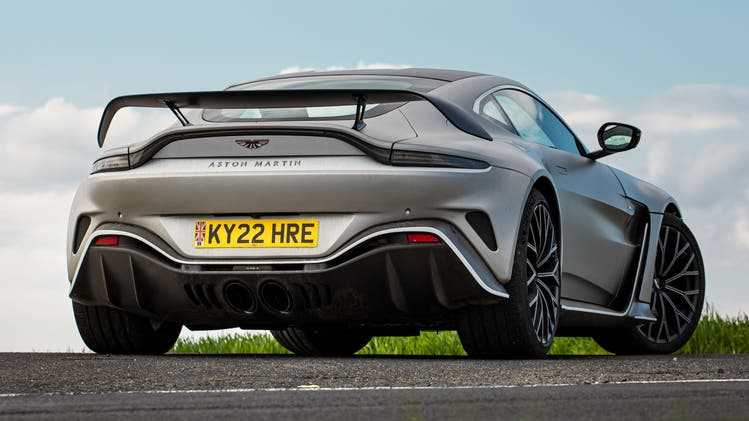
The pronounced diffuser with integrated tailpipes, together with the rear wing, ensures a significant reduction in lift on the rear axle.
Body rigidity has been increased thanks to front and rear shear plates, strut braces and fuel tank bracing. This ensures good contact with the road at all times, without the athlete showing excessive hardness – in every driving mode. This also has to do with the revised chassis. The V12 Vantage features a new adaptive damping system that includes new anti-roll bars, bushings, and spring and damper assemblies. Suspension spring rates have been increased by 50 percent at the front and 40 percent at the rear. The stabilizers are now a little stiffer at the front than on the V8 counterpart and much softer at the rear.
So much dynamic also wants to be destroyed accordingly, if necessary. This is ensured by standard carbon-ceramic brakes – at the front there are 410 mm discs with 6-piston brake calipers, at the rear there are 360 mm discs with 4-piston brake calipers. At least on the road, the system never gets tired even after many kilometers in the Eifel – we assume that it will be the same on the race track. A nice side effect: the new brakes save 23 kilos in weight compared to steel brakes.
Getting out of the Special and Final Edition is difficult for three reasons: firstly, the new and last V12 Vantage coupé fits like a perfect tuxedo after a short period of getting used to it, secondly, the side bolsters of the carbon seat shells prevent an elegant exit, and thirdly, there will probably not be another one Give a chance to be chauffeured by such 299,500 euros. Because the special series has already been completely sold. A completely new small athlete is only announced for 2025. fully electric.
